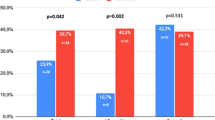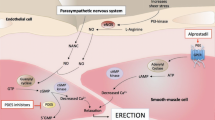Abstract
Phosphodiesterase type 5 inhibitors (PDE5i) is the only approved oral treatment for erectile dysfunction (ED) in the US, and alternative management remains necessary when this treatment fails or is contraindicated. Targeting other pathways than the NO-cGMP pathway and/or combining this approach with PDE5i may introduce new treatments for men who are unresponsive to PDE5i. This study aims to evaluate whether Mirabegron improves erectile function in men with concurrent overactive bladder and mild to moderate ED. Twenty subjects, 40–70 years old, registering International Index of Erectile Function (IIEF) score 11–25 and International Prostate Symptom Score 8–20, were treated with Mirabegron therapy for 12 weeks. Study participants were re-administered IIEF and OAB-q questionnaires on weeks 2, 4, 8, and 12 and assessed for adverse events. The primary and secondary endpoints were an increase in the IIEF-5 score of 4 units and a decrease in the Overactive Bladder questionnaire (OAB-q) symptom severity score of 10 units between study time points. Thirteen men completed the 12-week study. Mirabegron treatment improved the IIEF-5 scores in five patients (38.4%) by 4 points or more, whereas IIEF-5 scores were not affected by Mirabegron treatment in eight patients (61.5%). There were no clinically relevant decreases in the IIEF-5 score. Significant improvements were observed in intercourse satisfaction at week eight compared to baseline (p = 0.01). Orgasmic function and sexual desire were not affected by Mirabegron treatment. As expected, Mirabegron treatment reduced OAB symptoms based on OAB-q short form (p = 0.006) and OAB-q total health-related quality of life (HRQL) scores compared to baseline (p = 0.03). Residual bladder volumes were not affected by treatment. No serious side effects were reported during the study period. This study suggests that Mirabegron may improve both EF and OAB-related symptoms in some individuals without causing serious adverse events.
This is a preview of subscription content, access via your institution
Access options
Subscribe to this journal
Receive 8 print issues and online access
$259.00 per year
only $32.38 per issue
Buy this article
- Purchase on Springer Link
- Instant access to full article PDF
Prices may be subject to local taxes which are calculated during checkout



Similar content being viewed by others
References
NIH Consensus Conference. Impotence: NIH consensus development panel on impotence. JAMA. 1993;270:83–90.
Johannes CB, Araujo AB, Feldman HA, Derby CA, Kleinman KP, McKinlay JB. Incidence of erectile dysfunction in men 40 to 69 years old: longitudinal results from the Massachusetts male aging study. J Urol. 2000;163:460–3.
Rosen RC, Fisher WA, Eardley I, Niederberger C, Nadel A, Sand M. The multinational Men’s Attitudes to Life Events and Sexuality (MALES) study: I. prevalence of erectile dysfunction and related health concerns in the general population. Curr Med Res Opin. 2004;20:607–17.
Braun MH, Sommer F, Haupt G, Mathers MJ, Reifenrath B, Engelmann UH. Lower urinary tract symptoms and erectile dysfunction: comorbidity or typical “aging male” symptoms? Results of the “Cologne Male Survey”. Eur Urol. 2003;44:588–94.
Hatzimouratidis K, Hatzichristou DG. A comparative review of the options for treatment of erectile dysfunction: which treatment for which patient? Drugs. 2005;65:1621–50.
Limoncin E, Gravina GL, Corona G, Maggi M, Ciocca G, Lenzi A, et al. Erectile function recovery in men treated with phosphodiesterase type 5 inhibitor administration after bilateral nerve-sparing radical prostatectomy: a systematic review of placebo-controlled randomized trials with trial sequential analysis. Andrology. 2017;5:863–72.
Liao X, Qiu S, Bao Y, Wang W, Yang L, Wei Q. Comparative efficacy and safety of phosphodiesterase type 5 inhibitors for erectile dysfunction in diabetic men: a Bayesian network meta-analysis of randomized controlled trials. World J Urol. 2019;37:1061–74.
Cirino G, Sorrentino R, di Villa Bianca RD, Popolo A, Palmieri A, Imbimbo C, et al. Involvement of beta 3-adrenergic receptor activation via cyclic GMP- but not NO-dependent mechanisms in human corpus cavernosum function. Proc Natl Acad Sci U S A. 2003;100:5531–6.
Uchida H, Shishido K, Nomiya M, Yahamaguchi O. Involvement of cyclic AMP-dependent and –independent mechanisms in the relaxation of rat detrusor muscle via β–adrenoceptors. Eur J Pharmacol. 2005;518:195–202.
Hristov KL, Cui X, Brown SM, Liu L, Kellet WF, Petkov GV. Stimulation of beta-3-adrenoceptors relaxes rat urinary bladder smooth muscle via activation of the large-conductance Ca2+-activated K+ channels. Am J Physiol Cell Physiol. 2008;295:1344–53.
Mitidieri E, Tramontano T, Gurgone D, Imbimbo C, Mirone V, Fusco F, et al. β(3) adrenergic receptor activation relaxes human corpus cavernosum and penile artery through a hydrogen sulfide/cGMP-dependent mechanism. Pharmacol Res. 2017;124:100–4.
Maggiore ULR, Cardozo L, Ferrero S, Sileo F, Cola A, Del Deo F, et al. Mirabegron in the treatment of overactive bladder. Expert Opin Pharmacother. 2014;15:873–87.
Rosen R, Altwein J, Boyle P, Kirby RS, Lukacs B, Meuleman E, et al. Lower urinary tract symptoms and male sexual dysfunction: the multinational survey of the aging male (MSAM-7). Eur Urol. 2003;44:637–49.
Gur S, Peak T, Yafi FA, Kadowitz PJ, Sikka SC, Hellstrom WJ. Mirabegron causes relaxation of human and rat corpus cavernosum: could it be a potential therapy for erectile dysfunction? BJU Int. 2016;118:464–74.
Alexandre EC, Kiguti LR, Calmasini FB, Silva FH, da Silva KP, Ferreira R, et al. Mirabegron relaxes urethral smooth muscle by a dual mechanism involving beta3-adrenoceptor activation and alpha1-adrenoceptor blockade. Br J Pharm. 2016;173:415–28.
Rosen RC, Riley A, Wagner G, Osterloh IH, Kirkpatrick J, Mishra A. The international index of erectile function (IIEF): a multidimensional scale for assessment of erectile dysfunction. Urology. 1997;49:822–30.
Rosen RC, Cappelleri JC, Smith MD, Lipsky J, Pena BM. Development and evaluation of an abridged, 5-item version of the International Index of Erectile Function (IIEF-5) as a diagnostic tool for erectile dysfunction. Int J Impot Res. 1999;11:319–26.
Coyne KS, Thompson CL, Lai J-S, Sexton CC. An overactive bladder symptom and health-related quality of life short-form: validation of the OAB-q SF. Neurourol Urodyn. 2015;34:255–63.
Rosen RC, Allen KR, Ni X, Araujo AB. Minimal clinically important differences in the erectile function domain of the International Index of Erectile Function scale. Eur Urol. 2011;60:1010.
Carlson KV, Rovner ES, Nair KV, Deal AS, Kristy RM, Schermer CR. Factors associated with improvements in patient-reported outcomes during mirabegron or antimuscarinic treatment of overactive bladder syndrome: A Registry Study (PERSPECTIVE). Adv Ther. 2019;36:1906–21.
Herschorn S, Staskin D, Tu LM, Fialkov J, Walsh T, Gooch K, et al. Patient-reported outcomes in patients with overactive bladder treated with mirabegron and tolterodine in a prospective, double-blind, randomized, two-period crossover, multicenter study (PREFER). Health Qual Life Outcomes. 2018;16:69.
Ko KJ, Choo MS, Chang YS, Kim JC, Lee KS. A multicenter prospective study for overactive bladder patient treatment satisfaction with mirabegron after being unsatisfied with antimuscarinic therapy (FAVOR study). Neurourol Urodyn. 2020;39:2417–24.
Wagg A, Staskin D, Engel E, Herschorn S, Kristy RM, Schermer CR. Efficacy, safety, and tolerability of mirabegron in patients aged ≥65yr with overactive bladder wet: a phase IV, double-blind, randomised, placebo-controlled study (PILLAR). Eur Urol. 2020;77:211–20.
Chapple CR, Cruz F, Cardozo L, Staskin D, Herschhorn S, Choudhury N, et al. Safety and efficacy of mirabegron: analysis of a large integrated clinical trial database of patients with overactive bladder receiving mirabegron, antimuscarinics, or placebo. Eur Urol. 2020;77:119–28.
Lessing C, Schmitz A, Albers B, Schrappe M. Impact of sample size on variation of adverse events and preventable adverse events: systematic review on epidemiology and contributing factors. Qual Saf Health Care. 2010;19:1–5.
de Oliveira MG, Rojas-Moscoso JA, Bertollotto GM, Candido TZ, de A Kiguti LR, et al. Mirabegron elicits rat corpus cavernosum relaxation and increases in vivo erectile response. Eur J Pharmacol. 2019;858:172447.
Iitsuka H, Tokuno T, Amada Y, Matsushima H, Katashima M, Sawamoto T, et al. Pharmacokinetics of mirabegron, a β3-adrenoceptor agonist for treatment of overactive bladder, in healthy Japanese male subjects: results from single- and multiple-dose studies. Clin Drug Investig. 2014;34:27–35.
Krauwinkel W, van Dijk J, Schaddelee M, Eltink C, Meijer J, Strabach G, et al. Pharmacokinetic properties of mirabegron, a β3-adrenoceptor agonist: results from two phase I, randomized, multiple-dose studies in healthy young and elderly men and women. Clin Ther. 2012;34:2144–60.
Chapple CR, Dvorak V, Radziszewski P, Van Kerrebroeck P, Wyndaele JJ, Bosman B, et al. A phase II dose-ranging study of mirabegron in patients with overactive bladder. Int Urogynecol J. 2013;24:1447–58.
Frazier EP, Peters SL, Braverman AS, Ruggieri MR Sr., Michel MC. Signal transduction underlying the control of urinary bladder smooth muscle tone by muscarinic receptors and beta-adrenoceptors. Naunyn Schmiedebergs Arch Pharmacol. 2008;377:449–62.
McCambridge J, Witton J, Elbourne DR. Systematic review of the Hawthorne effect: new concepts are needed to study research participation effects. J Clin Epidemiol. 2014;67:267–77.
Funding
This investigator-sponsored research study was provided funding and drug support by Astellas Pharma Global Development Inc.
Author information
Authors and Affiliations
Corresponding author
Ethics declarations
Competing interests
ALB served as principal investigator on this clinical trial and he is a consultant/advisor for Astellas Pharmaceuticals.
Additional information
Publisher’s note Springer Nature remains neutral with regard to jurisdictional claims in published maps and institutional affiliations.
Rights and permissions
About this article
Cite this article
Karakus, S., Musicki, B. & Burnett, A.L. Mirabegron improves erectile function in men with overactive bladder and erectile dysfunction: a 12-week pilot study. Int J Impot Res 34, 588–592 (2022). https://doi.org/10.1038/s41443-021-00455-2
Received:
Revised:
Accepted:
Published:
Issue Date:
DOI: https://doi.org/10.1038/s41443-021-00455-2
This article is cited by
-
Overactive bladder negatively affects erectile function and promotes premature ejaculation: findings from large representative population-level study
World Journal of Urology (2024)
-
Conservative Non-surgical Options for Erectile Dysfunction
Current Urology Reports (2023)



